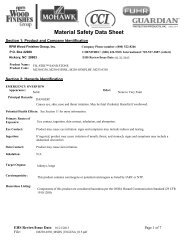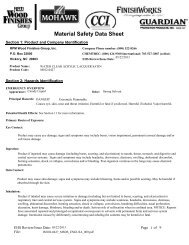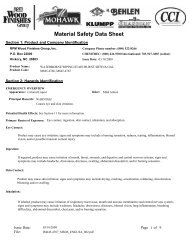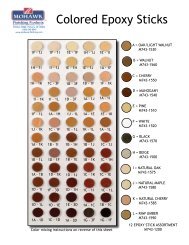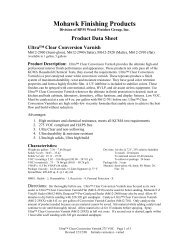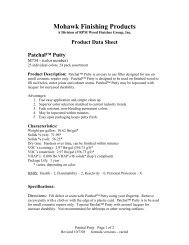MSDS - Mohawk Finishing Products
MSDS - Mohawk Finishing Products
MSDS - Mohawk Finishing Products
Create successful ePaper yourself
Turn your PDF publications into a flip-book with our unique Google optimized e-Paper software.
Section 1: Product and Company IdentificationMaterial Safety Data SheetRPM Wood Finishes Group, Inc. Company Phone number: (800) 522-8266P.O. Box 22000CHEMTREC: (800) 424-9300 International: 703-527-3887 (collect)Hickory, NC 28603EHS Review/Issue Date: 10/15/2011Product Name:Product Code:ULTRA MARK WHITE SANDM281-0011Section 2: Hazards IdentificationEMERGENCY OVERVIEWAppearance: Colored LiquidOdor:Moderately Strong AlcoholPrincipal Hazards:DANGER! Flammable.Harmful or fatal if swallowed. Vapor harmful. Causes eye irritation.Potential Health Effects: See Section 11 for more information.Primary Routes of Exposure:Eye Contact:Eye contact, ingestion, skin contact, inhalation, and absorption.Ingestion:Product may cause eye irritation; signs and symptoms may include a burning sensation, redness, tearing, inflammation, blurredvision, and/or possible transient corneal injury.Skin Contact:Product if ingested may cause damage (including burns, scarring, and ulcerization) to mouth, throat, stomach, and digestive andcentral nervous systems. Signs and symptoms may include headache, drowsiness, dizziness, swelling, abdominal discomfort,burning sensation, shock or collapse, convulsions and/or bleeding.Inhalation:Product may cause skin irritation; signs and symptoms may include drying, cracking, sensitization, reddening, discoloration,blistering and/or swelling.Product if inhaled may cause severe irritation or damage (including but not limited to burns, scarring, and ulcerization) torespiratory tract and central nervous system. Signs and symptoms may include weakness, headache, drowsiness, dizziness,swelling, abdominal discomfort, burning sensation, shock or collapse, convulsions, breathing difficulties, nasal perforation,ulceration, heart damage, blindness, bleeding and/or death. NOTICE: Reports have associated repeated and prolongedoccupational overexposure to solvents with permanent brain and nervous system damage. Intentional misuse by deliberatelyconcentrating and inhaling the contents may be harmful or fatal.EHS Review/Issue Date: 10/15/2011Page 1 of 9File:IM281-0011_<strong>MSDS</strong>_ENGUSA_006.pdf
Product Name:Material Safety Data SheetULTRA MARK WHITE SANDTarget Organs:Not DeterminedCarcinogenicity:This product contains carcinogens or potential carcinogens as listed by IARC or NTP.Hazardous Listing:Components of this product are considered hazardous per the OSHA Hazard Communication Standard (29 CFR1910.1200).Section 3: Composition/Information on Ingredientsethanolisobutanoltitanium dioxidepolyketone resinpolyketone resinisopropanolpm acetatedipropylene glycol monomethyl etheraliphatic hydrocarbonsaluminum hydroxideresinsilicaresinpolyoxyethylene tridecyl ether phosphatesurfactantwaterm-xyleneamorphous silicairon oxide yellow2-phenoxyethanolethylbenzeneo-xylenesiliconep-xyleneacrylic copolymerChemical CAS Percent Composition64-17-578-83-113463-67-7proprietaryproprietary67-63-0108-65-634590-94-88052-41-321645-51-2proprietary68909-20-6proprietary9046-01-9proprietary7732-18-5108-38-3112926-00-851274-00-1122-99-6100-41-495-47-6proprietary106-42-370892-90-950 - 7010 - 201 - 101 - 101 - 101 - 101 - 101 - 101 - 10< 1< 1< 1< 1< 1< 1< 1< 1< 1< 1< 1< 0.1< 0.1< 0.1< 0.1< 0.1Section 4: First Aid MeasuresEye Contact:If exposure occurs, flush the affected eye for at least 20 minutes. Tilt the head to prevent chemical from transferring to theuncontaminated eye. Seek medical attention immediately after flushing.EHS Review/Issue Date: 10/15/2011Page 2 of 9File:IM281-0011_<strong>MSDS</strong>_ENGUSA_006.pdf
Product Name:Material Safety Data SheetULTRA MARK WHITE SANDIngestion:Do not induce vomiting. Dilute with water or milk. Never give fluids if the victim is unconscious or having convulsions. Seekmedical attention immediately. Contact Poison Control Center immediately.Skin Contact:If exposure occurs, flush the affected area thoroughly with water for at least 15 minutes. Destroy contaminated clothing and shoes.Seek medical attention immediately.Inhalation:Remove to fresh air. If not breathing, administer CPR until help arrives or the victim starts to breathe on his own. If breathing isdifficult, give oxygen. Seek medical attention immediately.Section 5: Fire Fighting MeasuresExtinguishing Media:Use alcohol foam, dry chemical, carbon dioxide or any Class B fire extinguishing agent. Water may be unsuitable for extinguishingfires. Water may be used to cool and prevent the rupture of containers that are exposed to the heat from a fire.<strong>Products</strong> of Combustion:Combustion may produce carbon monoxide, carbon dioxide, and irritating or toxic vapors and gases.Protection of Firefighters / Explosion Hazards:Evacuate all persons from the fire area to a safe location. Move non-burning material, as feasible, to a safe location as soon aspossible. Fire fighters should be protected from potential explosion hazards while extinguishing the fire. Wear self-containedbreathing apparatus (SCBA) and full fire-fighting protective clothing. Thoroughly decontaminate all protective equipment after use.Containers of this material may build up pressure if exposed to heat (fire). Use water spray to cool fire-exposed containers. Usewater spray to disperse vapors if a spill or leak has not ignited. DO NOT extinguish a fire resulting from the flow of flammableliquid until the flow of the liquid is effectively shut off. This precaution will help prevent the accumulation of an explosive vapor-airmixture after the initial fire is extinguished.Section 6: Accidental Release MeasuresFollow personal protective equipment recommendations found in Section 8. Personal protection needs must be evaluated based oninformation provided on this sheet and the special circumstances created by the spill including; the material spilled, the quantity ofthe spill, the area in which the spill occurred, and the training and the expertise of employees in the area responding to the spill.Never exceed any occupational exposure limits. Shut off ignition sources; including electrical equipment and flames. Do not allowsmoking in the area. Do not allow the spilled product to enter public drainage systems or open waterways.EHS Review/Issue Date: 10/15/2011Page 3 of 9File:IM281-0011_<strong>MSDS</strong>_ENGUSA_006.pdf
Product Name:Material Safety Data SheetULTRA MARK WHITE SANDSection 7: Handling and StorageHandling:Empty containers may retain product residue or vapor. Do not pressurize, cut, weld, braze, solder, drill, grind, or expose container toheat, flame, sparks, static electricity, or other sources of ignition.Storage:Keep containers closed when not in use. Store in cool well ventilated space away from incompatible materials.Section 8: Exposure / Personal ProtectionOSHA 29 CFR 1910.1000 Air Contaminants – Tables:ChemicalCASZ-1 PEL(units as noted)Z-2 PEL(PPM)Z-3StatusSpecificallyRegulated see:ACGIH TLV(units as noted)ethanolisobutanoltitanium dioxidepolyketone resinpolyketone resin64-17-578-83-113463-67-7proprietaryproprietary1900 MGM3 (1000 PPM)300 MGM3 (100 PPM)15 MGM31000 PPM50 PPM10 MGM3isopropanolpm acetate67-63-0108-65-6980 MGM3 (400 PPM)200 PPMdipropylene glycol monomethyl etheraliphatic hydrocarbonsaluminum hydroxideresin34590-94-88052-41-321645-51-2proprietary600 MGM3 (100 PPM)2900 MGM3 (500 PPM)100 PPM100 PPMsilica68909-20-6resinproprietarypolyoxyethylene tridecyl ether phosphate9046-01-9surfactantproprietarywater7732-18-5m-xyleneamorphous silica108-38-3112926-00-8435 MGM3 (100 PPM)*100 PPMiron oxide yellow51274-00-12-phenoxyethanol122-99-6ethylbenzeneo-xylenesiliconep-xyleneacrylic copolymer100-41-495-47-6proprietary106-42-370892-90-9435 MGM3 (100 PPM)435 MGM3 (100 PPM)435 MGM3 (100 PPM)100 PPM100 PPM100 PPMEHS Review/Issue Date: 10/15/2011Page 4 of 9File:IM281-0011_<strong>MSDS</strong>_ENGUSA_006.pdf
Product Name:Material Safety Data SheetULTRA MARK WHITE SANDEngineering Controls:Use adequate ventilation to maintain airborne concentrations at levels below permissible or recommended occupational exposurelimits.Eye / Face Protection:Wear chemical-resistant glasses and/or goggles and a face shield when eye and face contact is possible due to splashing or sprayingof material.Skin Protection:Wear chemical resistant footwear and clothing such as gloves, an apron or a whole body suit as appropriate.Respiratory Protection:A NIOSH-approved air-purifying respirator with the appropriate cartridge may be appropriate under certain circumstances whereairborne concentrations are expected to exceed permissible exposure limits. Protection provided by air-purifying respirators islimited. Use a positive-pressure, air supplied respirator if there is potential for an uncontrolled release, exposure levels are notknown or any other circumstances where air-purifying respirators may not provide adequate protection.General Hygiene Considerations:It is good practice to avoid contact with the product and/or its vapor, mists or dust by using appropriate protective measures.Wash thoroughly after handling and before eating or drinking.Section 9: Physical and Chemical PropertiesPhysical State:Odor:Odor Threshold:pH:Freezing Point:Boiling Point:Flash Point ( o F):Evaporation Rate:Flammability (solid, gas):Upper Flammability Limit:Lower Flammability Limit:Vapor Pressure:Vapor Density:Colored LiquidModerately Strong AlcoholNot determined.Not determined.Not determined.Not determined.58 (CALC.)Not determined.Not determined.Not determined.Not determined.Not determined.Not determined.EHS Review/Issue Date: 10/15/2011Page 5 of 9File:IM281-0011_<strong>MSDS</strong>_ENGUSA_006.pdf
Product Name:Material Safety Data SheetULTRA MARK WHITE SANDSpecific Gravity:Weight per Gallon (lbs):Solubility (water):Partition Coefficient (n-octanol/water):Auto-ignition Temperature:Coating VOC g/l:Coating VOC lbs/gal:Material VOC g/l:Material VOC lbs/gal:Solids VOL%:Solids WT %:0.927.7Not determined.Not determined.Not determined.705.385.87705.385.8712.5823.51Contains Non-Photochemically Reactive Solvent.VOC data per US EPA guidelines. Some states and localities have guidelines more stringent than federal regulations.Aerosol coating product category codes and applicable reactivity limits are displayed on product labels per 40 CFR 59.507.Section 10: Stability and ReactivityStability:Stable under normal conditions.Conditions to Avoid/Incompatible Materials:Keep away from heat, sparks and flames.Hazardous Decomposition <strong>Products</strong>:Not determined.EHS Review/Issue Date: 10/15/2011Page 6 of 9File:IM281-0011_<strong>MSDS</strong>_ENGUSA_006.pdf
Product Name:Material Safety Data SheetULTRA MARK WHITE SANDSection 11: Toxicology InformationChemical CAS IARC NTPethanol 64-17-5 * *isobutanol78-83-1titanium dioxide13463-67-7polyketone resinproprietarypolyketone resinproprietaryisopropanol 67-63-0pm acetate 108-65-6dipropylene glycol monomethyl ether 34590-94-8aliphatic hydrocarbons8052-41-3aluminum hydroxide21645-51-2resinproprietarysilica68909-20-6resinproprietarypolyoxyethylene tridecyl ether phosphate 9046-01-9surfactantproprietarywater7732-18-5m-xylene108-38-3amorphous silica112926-00-8iron oxide yellow51274-00-12-phenoxyethanol122-99-6ethylbenzene100-41-4o-xylene95-47-6siliconeproprietaryp-xylene106-42-3acrylic copolymer70892-90-9Toxicological evaluation of this product as a whole has not been performed. Individual components that are potential or knowncarcinogens are listed above.Section 12: Ecological InformationEcological evaluation of this material has not been performed; however, do not allow the product to be released to theenvironment without governmental approval/permits.EHS Review/Issue Date: 10/15/2011Page 7 of 9File:IM281-0011_<strong>MSDS</strong>_ENGUSA_006.pdf
Product Name:Material Safety Data SheetULTRA MARK WHITE SANDSection 13: Disposal ConsiderationsWaste from this material may be a listed and/or characteristic hazardous waste. Dispose of material, contaminatedabsorbent, container and unused contents in accordance with local, state, and federal regulations.Section 14: Transportation InformationDOT Basic description:UN1263, PAINT, 3, IISee 49 CFR 172.101 for Special Provisions, Packaging, and Quantity Limitations.Section 15: Regulatory InformationChemical NameCASCERCLACERCLA RQEPCRA EHSEPCRA TPQSARA 313TSCADSLEINECSProposition 65WHMISethanol64-17-5* 100 LBS* * * **isobutanol78-83-1* 5000 LBS****titanium dioxide13463-67-7***polyketone resinproprietarypolyketone resinproprietaryisopropanol67-63-0*****pm acetate108-65-6***dipropylene glycol monomethyl ether34590-94-8****aliphatic hydrocarbons8052-41-3****aluminum hydroxide21645-51-2***resinproprietarysilica68909-20-6***resinproprietarypolyoxyethylene tridecyl ether phosphate9046-01-9surfactantproprietarywater7732-18-5***m-xylene108-38-3*1000 LBS*****amorphous silica112926-00-8**iron oxide yellow51274-00-1***2-phenoxyethanol122-99-6****ethylbenzene100-41-4*1000 LBS**** **o-xylene95-47-6*1000 LBS*****siliconeproprietaryp-xylene106-42-3*100 LBS*****acrylic copolymer70892-90-9**WARNING: This product contains a chemical known to the state of California to cause cancer and birth defects, orother reproductive harm.EHS Review/Issue Date: 10/15/2011Page 8 of 9File:IM281-0011_<strong>MSDS</strong>_ENGUSA_006.pdf
Product Name:Material Safety Data SheetULTRA MARK WHITE SANDSection 16: Other InformationIMPORTANT: WHILE THE DESCRIPTIONS, DATA AND INFORMATION CONTAINED HEREIN ARE PRESENTEDIN GOOD FAITH AND BELIEVED TO BE ACCURATE, IT IS PROVIDED FOR YOUR GUIDANCE ONLY. BECAUSEMANY FACTORS MAY AFFECT PROCESSING OR APPLICATION/USE, WE RECOMMEND THAT YOU PERFORMAN ASSESSMENT TO DETERMINE THE SUITABILITY OF A PRODUCT FOR YOUR PARTICULAR PURPOSE PRIORTO USE. NO WARRANTIES OF ANY KIND, EITHER EXPRESSED OR IMPLIED, INCLUDING FITNESS FOR APARTICULAR PURPOSE, ARE MADE REGARDING PRODUCTS DESCRIBED, DATA OR INFORMATION SETFORTH. IN NO CASE SHALL THE DESCRIPTIONS, INFORMATION,OR DATA PROVIDED BE CONSIDERED APART OF OUR TERMS AND CONDITIONS OF SALE. FURTHER, THE DESCRIPTIONS, DATA AND INFORMATIONFURNISHED HEREUNDER ARE GIVEN GRATIS. NO OBLIGATION OR LIABILITY FOR THE DESCRIPTION, DATAAND INFORMATION GIVEN ARE ASSUMED. ALL SUCH BEING GIVEN AND ACCEPTED AT YOUR RISK.HMIS Codes Health 2 Flammability 3 Reactivity 0Key to Abbreviations:* Item appears on indicated list (or inventory)ACGIHAmerican Conference of Governmental Industrial HygienistsCASChemical Abstract Service Registry NumberCERCLAComprehensive Environmental Response, Compensation, and Liability ActCERCLA RQ CERCLA Reportable QuantityCFRCode of Federal RegulationsCPRCardiopulmonary resuscitationDSLDomestic Substances List of CanadaEINECSEuropean Inventory of Existing Chemical SubstancesEPCRAEmergency Planning and Community Right-to-know ActEPCRA EHS EPCRA Extremely Hazardous SubstanceEPCRA TPQ EPCRA Threshold Planning Quantityo FFahrenheit degreesg/lGrams per litergalGallonsIARCInternational Agency for Research on Cancerlbs or LBS PoundsMGM3Milligrams per cubic meterMIRMaximum Incremental Reactivity<strong>MSDS</strong>Material Safety Data SheetNCPWHMIS Non-Controlled ProductNIOSHNational Institute of Occupational Safety and HealthNTPNational Toxicology ProgramOSHAOccupational Safety and Health AdministrationPELPermissible Exposure LimitPPMParts per millionProposition 65 California's Safe Drinking Water and Toxic Enforcement ActSARASuperfund Amendments and Reauthorization ActTLVThreshold Limit ValueTSCAToxic Substances Control ActUSEPAUnited States Environmental Protection AgencyVOCVolatile Organic CompoundVOLVolumeWTWeightWHMISCanadian Workplace Hazardous Materials Information SystemUNUnited NationsEHS Review/Issue Date: 10/15/2011Page 9 of 9File:IM281-0011_<strong>MSDS</strong>_ENGUSA_006.pdf



